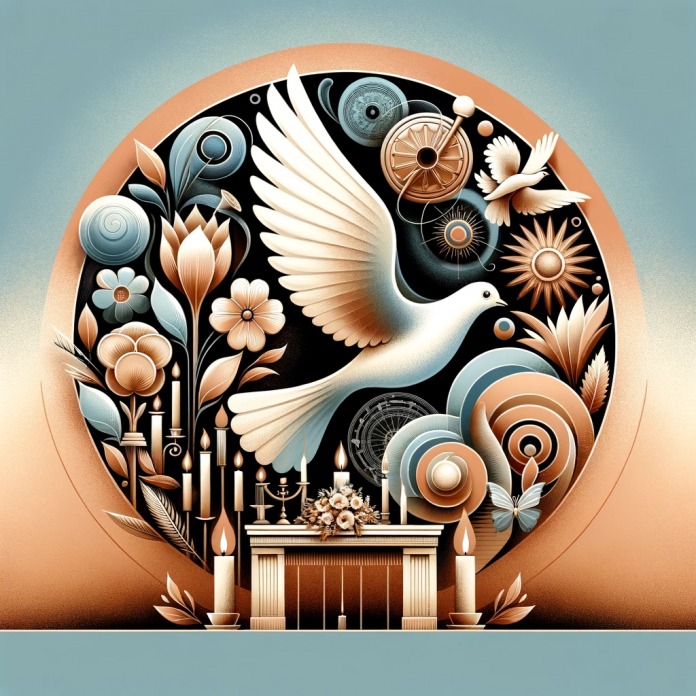Symbolism plays a significant role in funeral and memorial services, providing a profound way to express emotions, honor the deceased, and facilitate the grieving process. This article delves into the various symbols commonly used in these ceremonies and their meanings, offering insights into how they contribute to the overall experience and significance of the event.
Understanding Symbolism in Funeral and Memorial Services
Symbolism is a powerful tool that helps to convey complex emotions and ideas in a simple and meaningful way. In the context of funeral and memorial services, symbols are used to represent the life, personality, and values of the deceased, providing a tangible way for mourners to connect with their memories and feelings.
These symbols can take various forms, including objects, gestures, rituals, and even the location of the service. They are often deeply personal and can be tailored to reflect the unique life and beliefs of the person being remembered.
The Role of Objects as Symbols
Objects often serve as potent symbols in funeral and memorial services. They can be items that held significant meaning to the deceased or things that represent their interests, passions, or achievements. For example, a favorite book may be displayed to symbolize a love for literature, or a musical instrument may be present to represent a passion for music.
Flowers are another common symbolic object used in funerals and memorials. Different types of flowers and their colors can hold various meanings. For instance, lilies are often associated with the restored innocence of the soul of the deceased, while red roses symbolize respect, love, and courage.
Symbolism in Rituals and Gestures
Rituals and gestures are another integral part of the symbolism in funeral and memorial services. They can provide a sense of comfort and familiarity, helping mourners navigate the challenging process of grief and loss.
One common symbolic gesture is the act of releasing balloons or doves at the end of the service, symbolizing the soul's journey towards the heavens. Similarly, the ritual of lighting candles can represent the spirit's enduring light, offering a sense of hope and continuity.
The Influence of Cultural and Religious Beliefs
Cultural and religious beliefs often play a significant role in shaping the symbolism used in funeral and memorial services. These traditions can provide a framework for understanding and expressing grief, offering comfort and solace to the bereaved.
For instance, in Christian funerals, the cross is a prominent symbol representing faith, resurrection, and eternal life. Similarly, in Hindu ceremonies, the ritual of lighting a lamp symbolizes the illumination of the mind, knowledge, and the divine presence.
Symbolism in Different Cultures
Different cultures have unique ways of using symbolism in funeral and memorial services. For example, in Chinese tradition, white is the color of mourning, symbolizing purity and rebirth. Meanwhile, in Mexican culture, the Day of the Dead is marked by the creation of vibrant altars adorned with marigolds, candles, and personal mementos, symbolizing the celebration of life and remembrance.
In African cultures, dance and music often play a significant role in funerals, symbolizing the transition of the soul and the community's collective grief and healing. These examples illustrate the diversity and richness of funeral and memorial symbolism across different cultures.
Personalizing Symbolism in Funeral and Memorial Services
While traditional symbols can provide a sense of comfort and familiarity, personalizing symbolism can make a funeral or memorial service more meaningful and reflective of the deceased's life and personality.
For instance, if the deceased was an avid gardener, seeds or saplings could be given to attendees as a symbol of their love for nature and growth. If they were a passionate cook, their favorite recipe could be shared, symbolizing their love for food and bringing people together.
Creating a Symbolic Space
The location and setup of the service can also serve as a form of symbolism. For example, hosting the service in a place that was significant to the deceased, such as a favorite park or beach, can add a deeper layer of meaning to the ceremony.
Similarly, incorporating elements that reflect the deceased's interests and passions into the service setup can create a symbolic space that truly honors their life. This could involve displaying artwork, playing their favorite music, or even serving their favorite food.
Conclusion
Symbolism in funeral and memorial services serves as a bridge, connecting the tangible and the intangible, the physical and the spiritual. It offers a way to honor and remember the deceased, facilitating the expression of grief and the process of healing.
Whether traditional or personalized, these symbols provide a profound way to celebrate a life lived, offering comfort and connection in a time of loss. By understanding and incorporating meaningful symbols into these ceremonies, we can create a truly fitting tribute to the ones we have lost.


-banner.png)





